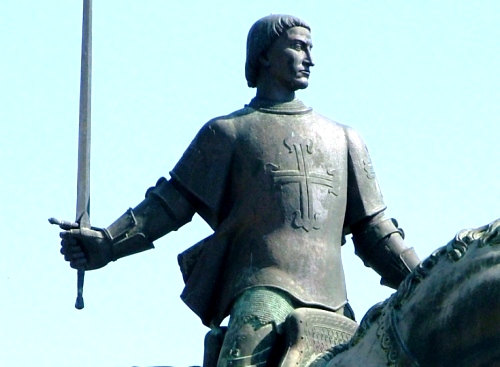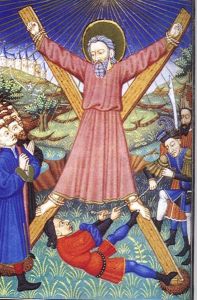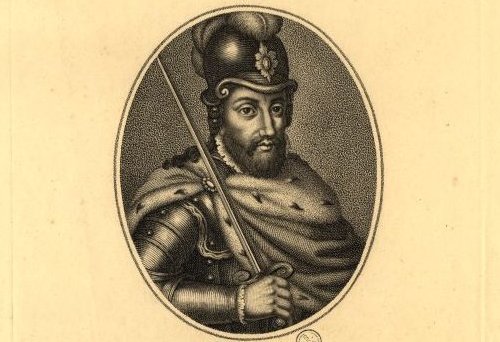Templar Survival in Portugal

Afonso de Santa Maria, Prince of Beira, Duke of Barcelos
Besides other ways of Templar survival, we are certain of their continuation in Portugal. That was through the Portugeuse Order of Christ, which is both a state and Vatican order today. When the Templars were suppressed, the King of Portugal, King Dinis, received an exemption from the Pope and all lands, castles, and knights were kept safe for the order. The name reverted to the original name of the order, the Order of Christ and the gift was in the hands of the king. The Pope only allowed this however, if he also was able to confer the Order of Christ. Thus there are two branches today of the Templars related to Portugal: “The Order of Christ,” which is a Portuguese order, and the highest order of the Vatican state (also called “The Order of Christ”). Only these two branches of the same order can claim to have any certain decent from the Templars.
Perhaps the future king of Portugal, Prince Afonso de Santa Maria, will choose to re-establishe the Knights Templar under his authority one day?
With sincere thanks to Templar Expert Sylvia Anginotti for putting together the following Portuguese chronology. If you end up near Portugal, a guided tour of the many Templar sites with Templar Knights of Tomar Tours is a must.
I – From the Templars to the Order of Christ
1307 Templars arrested in France. Many escape to Scotland. Many escape to Portugal where they are protected by King Dinis
1309 All Templar possessions and knights in Portugal are declared under the personal protection of King Dinis.
1312 After the Council of Vienna, the Order is dissolved by the Pope
1314 Jacques de Molay is burned at the stake in Paris. Pope Clement V dies.
1314 / 16 Vacancy in St. Peters throne, with the Cardinals resisting to elect a successor to Clement V.
1316 Pope John XXII is finally elected, choosing Avignon as his seat.
1317 King Dinis applies near the newly elected Pope in Avignon for the recognition of the Order of Christ, formed with the former Templar Knights and owner of all Templar possessions in the realm of Portugal.
1319 The Order of Christ is approved by Pope John XXII. D. Gil Martins, Master of the Order of Aviz is the first Master of the Order of Christ and the new Order is put under the spiritual guidance of… the Cistercian Monastery of Alcobaça. The seat is Castro Marim.
II – Order of Christ and Order of Aviz time of preparation for taking power
1320 Prince Pedro I is born
1325 King Dinis dies. King Afonso IV comes to the throne.
1336 Prince Pedro marries Constança, forced by his father
1336/55 Pedro and Inês love story and tragedy.
1357 King Afonso IV dies. Pedro I becomes King of Portugal. John, illegitimate son of King Pedro I, is born and taken under the care of the Order of Christ. The Order of Christ returns to Tomar and takes the former Templar castle and convent as its seat. This concludes the passage from the Templars to the Order of Christ, both in temporal and spiritual terms. Its now time to strengthen the Order of Aviz.
1364 When D. Martin de Avelar, Master of Aviz, dies, D. Nuno Frey de Andrade, Master of the Order of Christ and tutor of the young illegitimate Prince John, travels to Chamusca to meet King Pedro and request from him that he appoints his own son Master of Aviz. So, by appointment of King Pedro I, and the intervention of the Master of the Order of Christ, Prince John (of only 7 years of age) is designated Master of the Order of Aviz. This act consummates the move to take power in order to ensure the survival of the Templars. Prince John’s tutorship is still held by the Master of Christ until he becomes of age, although the education in arms was undertaken in Aviz.
1367 King Pedro I dies. His son D. Fernando comes to the throne.
1383 King Fernando dies, leaving no male heir to the throne. For two years Portugal is in turmoil as the menace of losing independence is imminent with the King of Castille plotting to acquire the throne by marriage. A growing wave of support claims that John, Master of Aviz, should become the new King. This movement is supported and encouraged by the Order of Christ.
1385 John, son of Peter I, Master of the Order of Aviz, becomes king by popular acclamation, supported by the majority of the Portuguese noble houses and foreign kings, such as Richard II from England. This inaugurated the Dynasty called of Aviz. Under the leadership of Nuno Álvares Pereira, with the Order of Aviz and the Order of Christ on each side, the Portuguese King John I, Master of Aviz, defeats a far stronger army sent by King John I of Castille in a deadly battle in Aljubarrota, just a few miles off Alcobaça. In effect the Order of Aviz takes the throne.
1387 Forging an even stronger relationship with England, King John I of Portugal marries Filipa of Lancaster, sister of the soon to be King Henry the IV of England.
Part III – The Outcome
1400’s Led by Henry the Navigator, first from Sagres and then from the Convent of Christ in Tomar, the Portuguese start the great era of Discoveries.
This has been a short account of the influence of the Order of Christ and the Order of Aviz during the preparatory post-Templar 14th century in Portugal.
Both orders, Templars / Aviz, were the true backbone of the nation in Medieval times. That work was reinforced, as we have seen, after the Templars gave way to the Order of Christ. The fact that John, long before he would be in a position to be acclaimed as king, was placed under the care of the Order of Christ and later appointed Master of Aviz, openly protected by the Master of Christ and by another Order of Aviz hero, Nuno Alvares Pereira, clearly shows the importance of both Orders in Portuguese historical events. The protection of both Orders given to the rise of a new dynasty, the Dynasty of Aviz with King John I, is in many ways similar to the protection given by the Templars at least after 1126 to the first dynasty, the Dynasty of Bourgogne with Afonso Henriques. Different players, but the same pattern altogether.

Nuno Alvares Pereira, companion of John I, with the Cross of the Order of Aviz
However, there are reasons to believe that deeper secrets are hidden under the political relevance of the Order of Aviz and the Order of Christ / Templars along Portuguese and hidden European history. In an article published in 1982 Portuguese researcher and author Olimpio Gonçalves, a leading authority on this subject, makes a few valuable points. Those who look deeper into history and look for the signs of what lies beneath – the reasons for the apparent reason – understand that the Soul of the Lusitan nation, later embodied in Portugal, is “tutored” – so to speak – by 3 Orders, of which the red cross of the Order of the Temple (reformed by King Dinis into Order of Christ, maintaining the distinctive red colour and initiatic mandate…) and the green cross of the Order of Aviz, form the two visible pillars that stand vigilant guard to the orb inside, so beautifully expressed in the national flag adopted in 1910.


The cross of Saint Andrew ( X ), patron of Scotland, is a particularly important symbol to meditate upon here, since in the Templar context it is indissolubly connected with the greek cross of Christ ( + ), both valuable keys to understand the octagon and the eight sided Templar buildings (Tomar, Segovia, London, Paris, etc. – Mosque of Omar) and the so called occult Orders (such as the Priory of Sion or whatever real Order could have existed instead, playing the real role supposed for this 20th century fabrication). In this context, studying the Scottish survival of the Temple – with Skye, Rosslyn and Henry Sinclair, and ignoring Portugal with Sintra, Tomar and Henry the Navigator, is to simply look at the reflex of a broader light. Both lines are complementary and one would not survive without the other. I hope to be able to elaborate a bit more on this later.

Cross of Saint Andrew, Patron of Scotland
The period between 1307 and 1385 is then characterized by preparatory work by the Order of Aviz and the Order of Christ which would both take centre stage in the political and scientific events that would follow soon. This preparatory work was undertaken in total discretion and very few documents prepare us for the flourishing years to come. The total eclipse of the Templar fleet and maps would give way to the Portuguese Discoveries, started early in the 1400’s, with vessels carrying the Cross of Christ to far away lands.

By 1307 Portugal – with extensive help of the Templars – already had a stable territory, most of which conquered from the Moors in the course of the Iberian Crusades. The south and west were nothing but a great opening to the vast and unknown Atlantic Ocean, full of legends and promises of hidden treasures. To the north it was divided from Galicia (a province of the Kingdom of Leon) by the Minho river and the border with the kings of Castille to the east was well defined since the times of the first Portuguese kings down to the south, where in the Algarve the fortress of Castro Marim (first seat of the Order of Christ) on the west bank of the Guadiana river, guarded the country from any foolish attempts that could have been made by the taifas (kingdoms) of the Moors of the Al-Andaluz. It would take the united Spanish kingdoms, under Isabel la Católica, almost 200 years more to conquer Granada in 1492 and close their side of the story as far as war with the Arabs was concerned.
Marriage between heirs to the throne of Aragon, Castille, Leon and Portugal were a common way to forge alliances and keep peace between Christian kings. However, there was always the danger that a king might die without male descent and another nation, by marriage, unite under a foreign country two territories. That had been the primary source of concern for the Portuguese crown since the early days. Falling under the crown of Castille would bring open war with the Moors again to a country that had been in relative peace for decades, in a favourable environment to see the flourishing of sciences, teaching, arts and commerce. Even Rome was far away on the horizon, many times neglecting this remote kingdom. The Portuguese kings had helped Castille in some battles against the Moors, especially when national borders might be at peril (Badajoz, Seville, Salado, etc.), but for the most part the time of the Reconquista was a thing from the past and smaller scale military warfare was only used in squabbles against neighbouring Christian Kingdoms. There were Arabs, Christians and Jews living side by side in the major Portuguese cities. Indeed some of the funding for the early Discoveries came from Jewish hands, showing how close the Order of Christ had come to that community. Unity with Castille would shake the Lusitan project from top to bottom and would throw a blanket of darkness and inquisitorial perusal into the practices, livelihood and teachings of a vast segment of the population. That “catastrophe” (interpreted by philosophers and poets as “catharsis”) only befell the nation centuries later, within a set of circumstances that are also of great interest for the students of Templar/Order of Christ history.

King Afonso IV
Amidst this prevailing fear, it was King Afonso IV’s primary concern to find a suitable bride for Prince Pedro I, future king. The choice fell on Princess D. Branca, granddaughter of King Sancho IV of Castille. However, by the age of 14 the Princess was very feeble and Prince Pedro absolutely refused to go ahead with this political marriage. His father then selected another suitable bride, D. Constança Manoel, daughter of one of the most noble lords of Castille, Leon and Aragon. However, Pedro rejected the bride as well, furious for not having been consulted on such a personal matter and not happy that she had already been rejected by King Alfonso XI of Castille before him. This choice wasn’t approved by Alfonso XI either. The intervention of the Master of the Order of Aviz was fundamental and, although Alfonso eventually accepted to have his former bride marry the Portuguese prince by means of a power of delegation, he held her prisoner in a tower in the city of Toro, preventing her from attending her own wedding. After a couple of years of active animosity, peace was finally signed in Seville and Constança travelled to join her husband in Coimbra. However Pedro was full of energy and passion for life, a great lover of hunting and not a very devoted husband. For a long time he didn’t pay attention to his duties as heir to the throne and led a life of pleasure, neglecting his wife that his heart never accepted.
One day his attention was captured by the fairest of the maids of his wife Constança. The ravishing beautiful Inês de Castro became the centre of his obsessive attention, causing scandal in the kingdom and severe misunderstandings with his father, King Afonso IV. It became such an important problem that Afonso IV was forced to retire Inês de Castro to a lonely and distant castle in the far away inaccessible lands of the Portuguese border. But if he thought that this would be enough to turn off his son’s love flame, he was in for a surprise. Pedro and Inês started to correspond with the help of intermediaries that would bring back and forth their love pledges and passionate writings. Pedro, like his grandfather King Dinis was a bit of a poet himself. It became a case of an impossible love. And the more impossible and distant, the more maddening and absorbing it got to restless Pedro. His duty to the nation – to have offspring – was being fulfilled with Constança, but his heart was fully united with Inês and the physical separation was unbearable.
In 1354 Constança died after having given birth to Prince Fernando (later to become King after his father, closing the Bourgogne Dynasty with his early death with no male heir). To great astonishment of the nation and repudiation of King Afonso IV, Pedro sees himself as a free man now and releases Inês from her exile, bringing her to openly live with him in an adulterous relationship, without marriage, establishing themselves first away from the agitated life of the court, but shortly after in the very city of Coimbra.

Pedro and Inês de Castro
The majority of Portuguese lords are not happy with the situation. Inês has two Spanish brothers that Pedro, to spite his enemies and his father, supports and advances politically. One of them even makes it as Constable of the Kingdom and Alcaide-Mor of Lisbon. As their love develops and the influence of the Spanish entourage of Inês grows, so their enemies become more and more suspicious and decide to warn King Afonso IV that the independence of the nation is at peril if nothing is done, since being followed in throne by his son Pedro, he could marry Inês, have offspring and then there would be little to prevent a full scale invasion from the Spanish kingdoms. To complicate matters even further, the Black Plague enters in Portugal and causes a wave of death of an unprecedented scale, causing famine and economical and political crisis. Many rush to condemn adulterous Inês as the cause of such misfortune and see the stubbornness of the Prince that didn’t want to lead the life of a heir to the throne with the nation’s best interests in mind, following instead his foolish passion, punished by Providence with the Plague.
Early in 1355 King Afonso IV is a divided man. He’s torn between reasons of state and his love as a father. Pedro declines all of his father’s suggestions of suitable brides to marry. Advisers of the King say that the reason might be that Pedro married Inês in secret. The only way out of the problem, they say, is to suppress Inês de Castro. His advisers eventually win and the King gives permission that the crime be carried out. Taking advantage of the fact that Pedro was an avid hunter, they prepare a trap to kill Inês while Pedro is away. It is said that the day Pedro was leaving for his hunting trip a great black dog leapt from amidst his dog pack and viciously run to attack Inês with fearful eyes of fire. The prince’s men were petrified and could not react, but Pedro, with one stroke of his sword decapitated the horrible dog whose blood stained fair Inês’s dress. Everyone became gloomy and the sense that grave things were close by was unmistakable. However Pedro decided to hold his departure no longer and bids a last goodbye to Inês.

Soon after Pedro leaves, King Afonso’s arrives with his men. Inês feels the danger and gathers her daughter and two sons and runs to the gardens. It’s in front of the Fonte das Lágrimas (Teardrop Fountain) that Inês pleads for the life of her children and says in her defence that her only sin is the undying love for Pedro. The King is inclined to use clemency, but three lords that were with him persuade the monarch that they should not back away from the mission. Shaken in his heart, Afonso spares the children, but allows for the lords to mercilessly behead Inês de Castro. To this day the Fountain spring is tainted in red.
Pedro was far away, hunting in the woods, in blissful ignorance of the tragedy.
Fernão Lopes, royal registrar, says about D. Pedro: “The hand of one that harms writes in sand, but the one who is harmed carves in marble and such was the case with D. Pedro.”
In Templar Chronicles IV – Alcobaça Part 3 we will finish the Pedro and Inês tragedy, we will understand why Pedro was known as “The Justice Bearer”, we will tell you about his relentless revenge and will look closely to their tombs since then in the Monastery of Alcobaça, face to face, each in one arm of the transept of the beautiful Cistercian church, so that when the Final Judgement comes and they are resurrected, each other will be the first person that each lover will see. To the end of the world…
To finalize for today, here is a chart detailing how the Order of the Temple survived as Order of Christ in Portugal under the protection of the Royal House and of the Order of Aviz, and how both Orders stood as two of the three secret pillars acting behind the courtains of history that lead to the Age of Discoveries with Prince Henry the Navigator, stepping in, in key moments.

Are you interested in learning more about the Templar history in Portugal?
Then click here:
Templars in Tomar
Bibliography
Gonçalves, Olímpio, Revista Graal, Comunidade Portuguesa de Eubiose, 1982
Lopes, Fernão, “Chronica Delrey Dom Pedro deste nome o primeiro e dos Reys de Portugal o oytavo”, edição do Padre José Pereira Bayam, Lisboa 1735
Monteverde, Amilio Achiles, “Resumo da Historia de Portugal”, Lisbo
a 1844
Pina, Ruy de; “Chronica de Elrey Dom Afonso o Quarto”, Lisbon 1653









